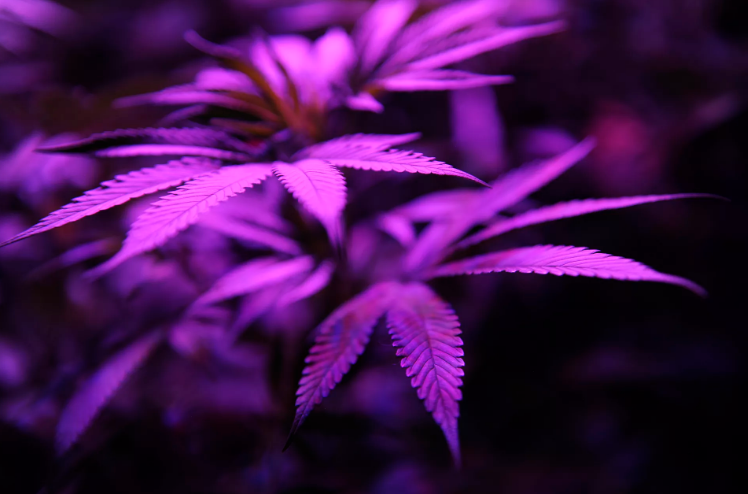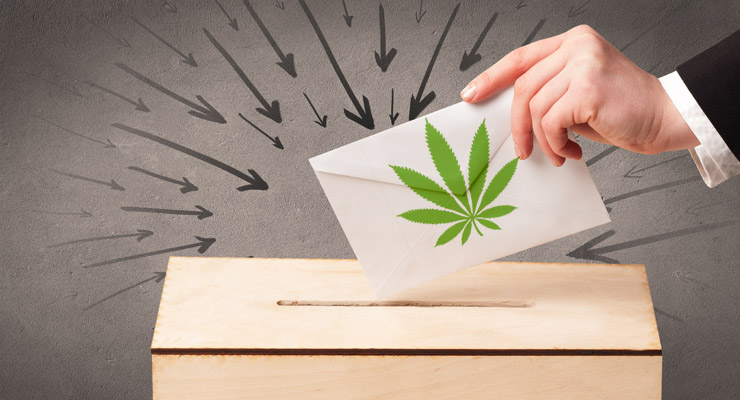By the end of the year, the number of people living in a state where marijuana is legal for recreational use could quadruple.
Five states – Arizona, California, Maine, Massachusetts, and Nevada – are set to vote on full marijuana legalization in November, potentially joining Colorado, Washington, Oregon, and Alaska among the states, along with Washington, DC, that have already legalized pot for recreational purposes.
And four other states – Arkansas, Florida, Montana, and North Dakota – will have medical marijuana initiatives on their ballots this November as well.
Together, the ballot measures mean 2016 could be the biggest year for marijuana reform yet.
One state is particularly important here: California. As the most populous state in the country, home to roughly 12 percent of the US population, many advocates hope that California will act as a bellwether that seals the tide of legalization across the country. After all, it was California that first legalized medical marijuana in 1996 – ushering in a movement that has led to half the states legalizing medical marijuana as of this year.
Support for full legalization has been building to this point for some time: According to Gallup, 58 percent of Americans now support legalization, up from 34 percent in 2001, and a tie for the peak in support in the pollster’s 46-year trend. (For reference, Hillary Clinton has around 46 percent support and Donald Trump has around 44 percent.)
This trend could be sealed if California follows suit – forcing federal and state officials to confront the reality that legalization may be here to stay in a very big way.
But before voters make their final decision in November, they will have to deal with a growing public debate about how America is handling legalization. Is enabling the rise of a for-profit marijuana industry truly wise, even if the prohibition of marijuana has led to horrible unintended consequences? Or are there better ways to legalize – or maybe even alternatives to full legalization? Those are some of the questions voters will have to confront before they cast their ballots – and they could decide whether California and other states really cement the legalization trend advocates are hoping for.
What each state’s marijuana legalization initiative would do – and whether it can win
Here’s what the ballot measures for full legalization do and their levels of support, based on reports by the advocacy group Marijuana Majority, the advocacy group Marijuana Policy Project, Ballotpedia, and news outlets:
Arizona: Legalizes up to 1 ounce of marijuana possession and retail sales for adults 21 years and older, allows up to 12 marijuana plants per residence, sets up the Department of Marijuana Licenses and Control to regulate the industry, and enforces a 15 percent excise tax on sales. The measure is in a close battle: One poll found half of Arizona voters favor legalization, another poll found most oppose it.
California: Legalizes up to 1 ounce of marijuana possession and retail sales for adults 21 years and older, allows up to six marijuana plants per household, sets up an agency within the Department of Consumer Affairs to regulate the industry, and enforces a 15 percent excise tax on sales along with a cultivation tax of $9.25 per ounce for flowers and $2.75 per ounce for leaves. The measure is likely to pass: Polls have consistently found majority support – above 60 percent in some surveys – for pot legalization.
Maine: Legalizes up to 2.5 ounces of marijuana possession and retail sales for adults 21 years and older, allows up to six flowering marijuana plants, 12 immature plants, and unlimited seedlings per residence, tasks the Department of Agriculture, Conservation, and Forestry with regulating the industry, and enforces a 10 percent tax on sales. The measure is in a close race, but seems likely to pass: Several polls have indicated majority support for legalization in the state.
Massachusetts: Legalizes up to 1 ounce of marijuana possession and retail sales for adults 21 and older and retail sales, allows up to 12 marijuana plants per household, creates an agency “similar to the Alcohol Beverage Control Commission” to regulate the industry, and enforces a 3.75 percent excise tax on sales. The measure seems surprisingly likely to lose: Early polls showed majority support for legalization, but recent ones found a plurality or even a majority oppose it.
Nevada: Legalizes up to 1 ounce of marijuana possession and retail sales for adults 21 and older, allows people who don’t live within 25 miles of a retail outlet to grow up to six marijuana plants per household, tasks the Nevada Department of Taxation with regulating the industry, and enforces a 15 percent excise tax paid by cultivators. The initiative has a decent chance of passing: A recent poll found 50 percent of Nevada voters support legalization, while 41 percent oppose it.
And here’s what the ballot measures for medical marijuana do, as well as their levels of support:
Arkansas: Legalizes marijuana for a wide range of medical conditions (from pain to traumatic brain injury to anorexia) with permission from a doctor and regulators, allows for nonprofit medical marijuana dispensaries, lets patients who live more than 20 miles away from a dispensary grow up to five mature marijuana plants and five seedlings, and tasks the Arkansas Department of Health with regulation. The measure has a good chance of passing: Polls, going back to 2015 and recently, have found that most Arkansas voters – up to 68 percent – support medical marijuana legalization.
Florida: Legalizes marijuana for specific medical conditions (cancer, epilepsy, HIV, PTSD, and other similarly severe illnesses) with permission from a doctor, allows medical marijuana dispensaries, and charges the Florida Department of Health with regulation. The measure will need at least 60 percent support to win under Florida law, but it’s set to achieve that: All major public polls this year have found it above 60 percent support.
Montana: Unlike other states on this list, Montana already has a medical marijuana law after 62 percent of voters approved it in 2004. But in 2011, state lawmakers passed severe restrictions on the law, making it much harder for patients to actually get their pot. This new initiative essentially undoes many of those restrictions, while enacting some new regulations and fees related to licensing. It’s hard to say how the measure will hold up on a vote – a clear majority of Montanans support medical marijuana, as the 2004 vote shows, but there haven’t been any polls on Montana’s 2016 measure.
North Dakota: Legalizes marijuana for specific medical conditions (cancer, epilepsy, HIV, PTSD, chronic back pain and other similarly severe illnesses) with written permission from a doctor, allows medical marijuana dispensaries, lets patients who live more than 40 miles away from a dispensary grow up to eight marijuana plants, and tasks the North Dakota Department of Health with regulation. It’s unclear whether this measure will pass: A 2014 poll found that 47 percent of North Dakotans support and 41 percent oppose legalizing medical marijuana, but no recent polls have been carried out.
Other potential initiatives include a full legalization measure in Michigan and medical marijuana measures in Missouri and Oklahoma. But it’s unclear if they’ll make it on the ballot in time, as they’re currently caught up in procedural and legal hurdles.
Even if these states legalize, it’s worth noting that marijuana remains totally illegal at the federal level. The federal government classifies marijuana as a schedule 1 drug – meaning they consider it to have a high potential for abuse and no recognized medical value, and therefore prohibit it for all purposes. Still, under the Obama administration, the federal government has largely taken a hands-off approach to states that legalize.
So what should voters think about as they head to the polls in these states? There is really one big argument for legalization and one big argument against it.
Legalization solves the unintended consequences of prohibition
The argument for full legalization is simple: Yes, marijuana is a drug that some people can abuse and get in trouble with. But the risks attached to pot abuse are enormously outweighed by the unintended consequences of continued prohibition – specifically, more violent crime and incarceration.
In the US, hundreds of thousands of people are arrested for pot possession each year, ripping communities and families apart as people are thrown in jail or prison. There are enormous racial disparities in these arrests, with black people 3.7 times as likely to be arrested for marijuana possession than their white counterparts despite being only 1.3 times as likely to use the drug.
Around the world, drug cartels and gangs also use profits from marijuana shipped to the US to maintain their stranglehold over trafficking routes – particularly in Latin America.
Historically, marijuana sales to the US made up a big chunk of drug cartels’ drug export revenue: as much as 20 to 30 percent, based on previous estimates from the Mexican Institute of Competitiveness in 2012 and the RAND Corporation in 2010. This revenue lets criminal groups carry out violent trafficking operations in much of Latin America, contributing to the killing and kidnapping of tens of thousands of people each year and horrifying stories of cartels beheading and torturing people. And some violence occurs in the US, where gangs fight over turf to position themselves to sell illegal drugs.
Legalization would help address this: When marijuana sales shift from the black market to the legal market, drug cartels lose out on the profits as they go to legal businesses instead. And without that money – up to 30 percent of cartels’ drug export revenue – these criminal organizations are going to have a harder time paying for and carrying out their dangerous activities around the world.
The risk is legalization could lead to more use and abuse by making pot cheaper and more available. Mark Kleiman, a drug policy expert at New York University’s Marron Institute estimates that a legal marijuana joint will cost no more to make than, say, a tea bag – since both products come from plants that are fairly easy to grow. And it would also be available to anyone (21 and older) in retail outlets after legalization – meaning it would no longer require a shady or secretive meeting with a drug dealer. Those are benefits for responsible marijuana users, to be sure, but easier access could also be a risk for those who aren’t responsible.
Still, marijuana isn’t associated with that much harm. It does carry some risks – including dependence and overuse, accidents, nondeadly overdoses that lead to mental anguish and anxiety, and, in rare cases, psychotic episodes. But it has never been definitively linked to any serious ailments – not deadly overdoses, lung disease, or schizophrenia – and it’s much less likely – around one-tenth so, based on data for fatal car crashes – to cause deadly accidents than the totally legal alcohol.
In fact, there’s some evidence that marijuana could be beneficial to some people. A review of the research, published in 2015 in the Journal of the American Medical Association, found solid evidence that pot can treat pain and muscle spasms. The pain component is particularly important, because other studies have suggested that pot can replace pain patients’ use of highly addictive, potentially deadly opioid painkillers – meaning medical marijuana legalization could literally save lives. (Much more on all of that here.)
So you have the serious harms of prohibitions: hundreds of thousands of arrests and drug-related violence. And you have the relatively small risks that are potentially prevented by keeping the drug illegal and less accessible: drug abuse, nondeadly overdoses, and, rarely, psychotic episodes. Plus you have the potential medical benefits. Given all of that, many Americans – a majority, based on polling on legalization – have concluded that the pros of prohibition simply don’t outweigh the cons.
But even if that’s the right call, that doesn’t mean the current way that states are legalizing is necessarily the right call.
There’s a big problem with the current model for legalization
The major concern with full legalization is that big, for-profit companies will get into the marijuana industry and market the drug in ways that encourage widespread use and abuse.
Legalization opponents cite the alcohol industry as an example of the worst-case scenario: Big Alcohol has successfully lobbied lawmakers to block tax increases and regulations on alcohol, all while marketing their product as fun and sexy in television programs – such as the Super Bowl – that are viewed by millions of Americans, including children. Meanwhile, alcohol is linked to 88,000 deaths each year in the US.
Kevin Sabet, co-founder of the anti-legalization Smart Approaches to Marijuana (SAM), previously told me that this kind of scenario with pot is his group’s biggest concern:
Drug policy experts like Kleiman and Beau Kilmer at the RAND Corporation point to Colorado, where one study of the state’s pot market conducted by the Marijuana Policy Group for the Colorado Department of Revenue found the top 29.9 percent heaviest pot users in the state made up 87.1 percent of demand for the drug. For the marijuana industry, that makes the heaviest users the most lucrative customers – meaning pot businesses have a financial incentive to encourage more heavy use and even abuse.
If marijuana companies are able to act like the tobacco and alcohol industries have in the past, there’s a good chance that they’ll convince more Americans to try or even regularly use marijuana, and some of the heaviest users may use more. And as these companies increase their profits, they’ll be able to influence lawmakers in a way that could stifle regulations or other policies that curtail abuse.
So why is abuse such a big concern, particularly for a drug that has very few direct health harms? As Jon Caulkins, a drug policy expert at Carnegie Mellon University, previously told me, “At some level, we know that spending more than half of your waking hours intoxicated for years and years on end is not increasing the likelihood that you’ll win a Pulitzer Prize or discover the cure for cancer.”
SAM argues this concern should essentially doom legalization. They worry that once the country legalizes a drug with the potential for profit, the country, through state and federal legal changes, will inevitably march in that direction – much like it has for tobacco and alcohol.
But legalization experts like Kleiman, Caulkins, and Kilmer note that states can go about legalization in different, potentially more responsible ways.
There are alternatives to the standard model of legalization, but no state is taking them up
The voter-approved laws that passed in the states (but not DC) have been broadly the same – taking up a commercial model that lets for-profit enterprises grow, sell, and market marijuana in a way that likely isn’t the best option for public health and safety. And 2016’s ballot initiatives all appear to continue that trend, with all the measures for recreational legalization allowing for for-profit sales.
But as drug policy experts noted in a 2015 RAND Corporation report on how Vermont, specifically, could legalize marijuana, there are various options for marijuana policy:
- Legalize marijuana through an alcohol-style model, where pot is sold largely for profit.
- Repeal penalties for marijuana without any regulations for how it will be sold.
- Allow adults to grow their own marijuana, even as marijuana sales remain illegal.
- Allow distribution of marijuana only within small co-ops or buyers’ clubs.
- Allow only locally controlled retail sales.
- Allow only state government-operated retail outlets. (Basically, the government would directly sell pot — much like some states do with liquor stores.)
- Allow a public authority to manage marijuana growing and sales.
- Allow only nonprofit organizations to sell marijuana.
- Allow only for-benefit companies to sell pot.
- Allow only a very limited number of for-profit outlets to sell marijuana.
Still, the noncommercial options remain an academic exercise – with zero states pushing the alternatives to date. One possible reason: There’s just no money in the approaches that don’t commercialize.
Increasingly, the marijuana legalization movement has been tied to the pot industry. You can see this in California – where donors with ties to the industry are among the biggest contributors to the legalization effort. If legalization didn’t create a for-profit industry for these contributors to benefit from, chances are they wouldn’t be donating at all or as much. And without those contributions, legalization advocates may not be able – or at least as able – to mount the kind of big campaign required to legalize, especially in a large state like California.
(On the other side, there’s evidence that the pharmaceutical and alcohol industries are working to fight marijuana legalization, perhaps because they see it as threats to their medical and recreational products. So this goes both ways to some extent.)
Some legalization advocates cop to their growing ties to the industry. Ethan Nadelmann, the executive director of the pro-legalization Drug Policy Alliance, previously told me that he has long expected the marijuana industry to grow and become a bigger part of the drug policy reform movement as legalization spread.
“On some level, we have always known that,” he said. “And I think 2016 may be the last year in which drug policy reform organizations, driven primarily by concerns of civil liberties and civil rights and other good public policy motivations, will be able to significantly shape the legislation. And I assume that as the years progress, various industry forces will loom ever larger.”
But the sole push for commercialized legalization, with no alternatives on the ballot or legislatures, leaves voters with two options for marijuana: keep it illegal or legalize and commercialize it. It’s a simplistic argument over legalization – focused on whether to do it instead of how to do it. But when faced with just the two choices, voters – fed up with the failures of prohibition – have seemingly embraced the legalization option available to them.
So if California and other states ring as bellwethers this November, it really could mean doom for the failed policy of prohibition – but the replacement may not be the best possible result for public health and safety.

News Moderator: Katelyn Baker 420 MAGAZINE ®
Full Article: 2016’s Marijuana Legalization Votes, Explained
Author: German Lopez
Contact: Vox
Photo Credit: Seth McConnell
Website: Vox














